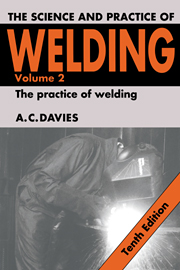Book contents
- Frontmatter
- Contents
- Preface
- 1 Manual metal arc welding
- 2 Gas shielded metal arc welding
- 3 Tungsten electrode, inert gas shielded welding processes (TIG), and the plasma arc process
- 4 Resistance welding and flash butt welding
- 5 Additional processes of welding
- 6 Oxy-acetylene welding
- 7 Cutting processes
- 8 The welding of plastics
- Appendixes
- City and Guilds of London Institute examination questions
- Index
1 - Manual metal arc welding
Published online by Cambridge University Press: 11 May 2010
- Frontmatter
- Contents
- Preface
- 1 Manual metal arc welding
- 2 Gas shielded metal arc welding
- 3 Tungsten electrode, inert gas shielded welding processes (TIG), and the plasma arc process
- 4 Resistance welding and flash butt welding
- 5 Additional processes of welding
- 6 Oxy-acetylene welding
- 7 Cutting processes
- 8 The welding of plastics
- Appendixes
- City and Guilds of London Institute examination questions
- Index
Summary
The electric arc
An electric arc is formed when an electric current passes between two electrodes separated by a short distance from each other. In arc welding (we will first consider direct-current welding) one electrode is the welding rod or wire, while the other is the metal to be welded (we will call this the plate). The electrode and plate are connected to the supply, one to the + ve pole and one to the – ve pole, and we will discuss later the difference which occurs when the electrode is connected to – ve or +ve pole. The arc is started by momentarily touching the electrode on to the plate and then withdrawing it to about 3 to 4 mm from the plate. When the electrode touches the plate, a current flows, and as it is withdrawn from the plate the current continues to flow in the form of a ‘spark’ across the very small gap first formed. This causes the air gap to become ionized or made conducting, and as a result the current is able to flow across the gap, even when it is quite wide, in the form of an arc. The electrode must always be touched on to the plate before the arc can be started, since the smallest air gap will not conduct a current (at the voltages used in welding) unless the air gap is first ionized or made conducting.
- Type
- Chapter
- Information
- The Science and Practice of Welding , pp. 1 - 91Publisher: Cambridge University PressPrint publication year: 1993



